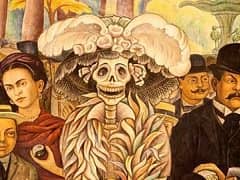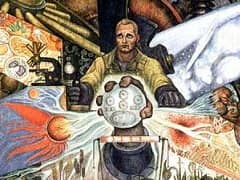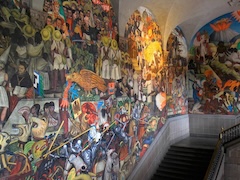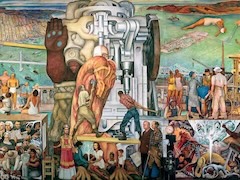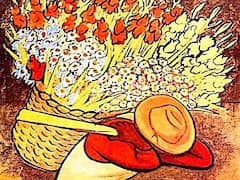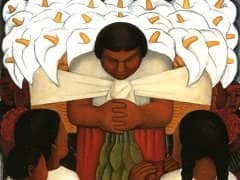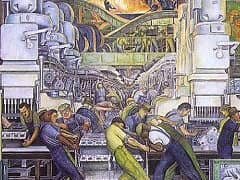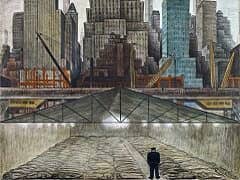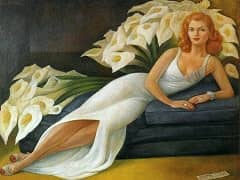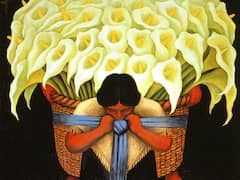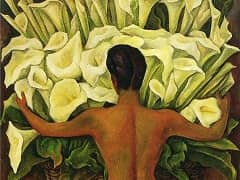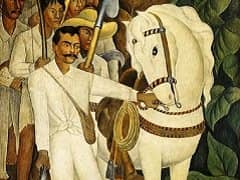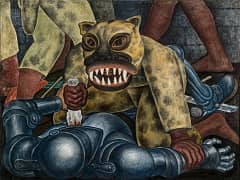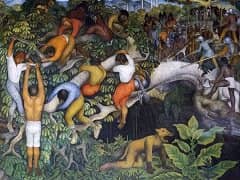Diego Rivera Biography
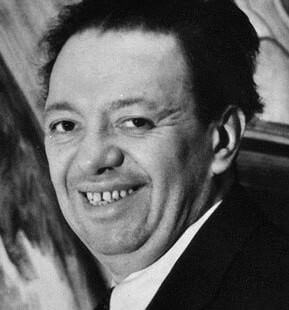
The public persona of Diego Rivera and the heroic status bestowed upon him in Mexico was such that the artist became the subject of myth in his own lifetime. His own memories, as recorded in his various autobiographies, have contributed
to his image as a precocious child of exotic parentage, a young firebrand who fought in the Mexican Revolution, and a visionary who completely repudiated his participation in the European avant-garde to follow a predestined course as the
leader of Mexico's art revolution.
The facts are more prosaic. The product of a middle-class family, the young artist completed an academic course of training at the prestigious Academic course of San Carlos before leaving Mexico for the traditional period of European study.
During his first stay abroad, like many other young painters, he was greatly influenced by Post-Impressionists Paul Cezanne, Van Gogh, and
Gauguin. As for participating in the early battles of the Mexican Revolution, recent research would seem to indicate that he did not. Although he was in Mexico for a time in late 1910-early 1911, his tales
of fighting with the Zapatistas cannot be substantiated.
From the summer of 1911 until the winter of 1920, Rivera lived in Paris. This period of his career has been brilliantly illuminated by Ramon Favela in the 1984-85 exhibition "Diego Rivera: The Cubist Year." The work of these years reveals diverse
influences, from the art of El Greco and new applications of mathematical principles, in which Rivera had been well schooled at San Carlos, to subject matter and techniques that reflect the discussions on the role
of art in the service of the revolution that preoccupied the community of emigre artists in Montparnasse.
During this time period, Diego Rivera left Spain for a long tour in France, Belgium, Holland and England hoping to solve a problem he couldn't really define. He admired greatly the work of Breughel, Hogarth and
Francisco Goya. He wished that his work could provoke the intense feeling got when he looked at their work. In Paris he went to a shop where he saw the work of newer painters who called themselves Cubists.
He saw Picasso's Harlequin and paintings by Georges Braque and Derain. Rivera spent hours in Paris looking at paintings by
Cezanne. Rivera would become a part of this Parisian art world for a decade. He would argue, study, paint, learn so much and do so much; yet at the end of ten years he still felt that something was absent from
his work. His paintings seemed only to be enjoyed by well-educated people who could afford to buy them for their homes. He thought that art should be enjoyed by everyone-especially poor, working people. He was developing a growing interest in the masses
and began to deepen his understanding of the folk art and ancient masterpieces of his native land. Art, Rivera felt, was never so isolated from life as when he was there in Europe.
Even after settling in Paris, Rivera returned every year to Spain to paint - often in the style of cubists such as Pablo Picasso, Salvador Dali, and
Paul Klee. During the years from 1913 to 1918, Rivera devoted himself almost entirely to cubism and found himself getting caught up in his search for new truths. Among his works during this period were
Portrait of Two Women, Portrait of Ramon Gomez, Eiffel Tower,
and Still Life, 1918. In all of these paintings and indeed of the cubist style as a whole it appeared that the artists took apart their subjects and created new objects of their own creation.
By 1917, River had begun to turn away from Cubism, and by 1918 his rejection of Cubist style, if not all the tenets of Cubism, was complete. The reasons for this rejection have not been completely determined, but certainly the inspiration of the Russian Revolution and the general return to realism among European artists were factors that contributed. In 1920, Rivera went to Italy. There, in the murals of the Italian partners of the quattrocento, he found the inspiration for a new and revolutionary public art capable of furthering the ideals of the ongoing revolution in his native land.
Rivera returned to Mexico in 1921 and soon became one of a number of Mexican and foreign artists who received commissions for murals in public buildings from the new government. By 1923, the completion of the first of his monumental series at the
Secretaria de Educacion Publica and his assumption of control over the decoration of the entire building had established his preeminence in the movement now known as the Mexican Mural Renaissance.
In his work at the Secretaria, which would occupy him for another four years, and in the chapel at the former Escuela de Agricultura at Chapingo, Rivera brought to full development his classical figure style and his epic approach to historical painting,
which focused on subjects that promoted revolutionary ideas and celebrated the indigenous cultural heritage of Mexico.
In the period following World War I, the literary, artistic, and intellectual vitality of post-revolutionary Mexico, in which the mural movement played an integral role, created a cultural "mecca" that drew young artists from the United States, Europe,
and Latin America. As a result, by the late 1920s, Rivera's murals, and those of Jose Clemente Orozco and David Alfaro Siqueiros, were well known in the United States. In the early 1930s, Rivera became one of the most sought-after artists in this country.
In addition to numerous commissions for easel paintings, his received commissions for three murals in San Francisco and was given a one-person exhibition at the Museum of Modern Art. Also, his costume and set designs were used in the ballet H. P.
(horsepower), which premiered in Philadelphia; he decorated the central court of Detroit Institute of Arts; he was invited by General Motors to create murals at the Chicago World's Fair, and he painted murals at Rockefeller Center and the New Workers School
in New York.
Rivera's sojourns in the United States were pivotal to his work. For the first time in his career as a muralist, he was separated from the rich cultural history upon which he drew for his subjects and was under no compulsion to confine himself to the themes in
promotion of Mexican nationalist ideals. He was also able, at least temporarily, to escape from the turmoil of his precarious political position in Mexico, where the Mexican Communist Party, of which he had been a member between 1922 and 1929, disapproved of
his growing ties to Mexico's government. Finally, he was at last able to indulge his deep fascination with technology, which was evident in a highly developed from in the industrial society of the United States.
Rivera's period of work in the United States enabled him to explore an industrial society, to analyze the role of the artist within it, to postulate his link to the universal order by analogy with earlier societies such as that of the Aztecs, and finally to
present his own concept of a new society based on science and technology. The murals in the United States served to clarify his understanding of his native Mexico and expanded his personal philosophy. They were the source of inspiration for many of his later
works, including the late murals at the Palacio Nacional and those at the Golden Gate Exposition in San Francisco, the Lerma waterworks, and the Hospital de la Raza.
Rivera's activities in the United States were marked by controversy. In Detroit, he was accused of using sacrilegious and even pornographic subject matter, his politics were questioned, and he was criticized for causing the dreaded industry to invade the museum.
The safety of the murals was even threatened until Edsel Ford made a public statement in their defense. Rivera, who believed that Detroit Industry Fresco cycle was his greatest artistic achievement, was dismayed by these attacks.
An even larger and more bitter controversy erupted at Rockefeller Center in New Yor when Rivera included a portrait of Lenin in his representation of the new society. Asked to remove it, Rivera refused and the mural was ultimately destroyed, on the greatest
scandals of art history. When Rivera returned to Mexico in December 1933, he was one of the most highly publicized artists in United States history, hailed by the intellectual left and the art community and scorned by conservatives and the corporate patrons who
had once sought him out.
Rivera's influence on American artists continued throughout the 1930s through the agency of the mural section of the Federal Art Project of the works Progress Administration. This project, which owed its very creation to the example of the Mexican government's
commissioning of works for public buildings, distributed to participating artists a handbook outlining Rivera's fresco technique.
Rivera's popularity with the American public continued into the 1940s, but his reputation among art critics and scholars diminished as realism and emphasis on social content fell into disfavor in the face of a growing interest in the styles of Cubism, Dada, and
Surrealism, then being brought to this country by European artists fleeing Hitler.
It is perhaps understandable that Rivera's work became inextricably linked with social realism. His trip to the U.S.S.R. in 1927-28 brought him into contact with many young Russian artists who later carried out government mural commissions, and his works were well
known in Moscow through the publication of newspaper and magazine articles. The artists, such as Ben Shahn, with whom Rivera associated during his two stays in New York were politically active individuals who, like their Russian counterparts, admired Rivera as the
great revolutionary who had put into practice what they still hoped to achieve. Rivera's political philosophy and the subject of his murals did create a common bond between his work and that of the social realists. However, his mural style, indeed his overall aesthetic,
modeled as it was on his studies of Italian Renaissance frescoes, classical proportions, pre-Colombian sculptural forms, Cubist space, and Futurist conventions of movement, bears little relationship to social realism.
Over the past forty years, the critical opinion in the United States has remained virtually unchanged: Rivera's work and the Mexican mural movement as a whole have been characterized as politically motivated, stylistically retrograde, and historically isolated. Furthermore,
Mexican scholars have traditionally emphasized the overt revolutionary ideals and didactic content of Rivera's murals in Mexico, thus extolling the very aspects of his work that have carried a negative connotation in the United States. In Mexico Rivera's work is synonymous
with institutionalized ideals of the Mexican Revolution, which promoted indigenous culture to the exclusion of foreign influence. As a consequence, in Mexico the vast body of published literature on Rivera has concentrated on his Mexican murals, while little attention has
been given to his work in the United States and Europe or to his easel paintings and drawings.
Rivera's own statements support this view of his art as a unique and indigenous effort in service of revolutionary ideals. In his autobiography, "My Art, My Life", his Paris years and his sojourn in Italy are acknowledged as preparation for the creation of new revolutionary
murals, but he characterized the formation of his mural style as spontaneously generated from indigenous Mexican culture:
My homecoming produced an aesthetic exhilaration which it is impossible to describe. It was as if I were being born anew, born in a new world... I was in the very center of the plastic world, where forms and colors existed in absolute purity. In everything I saw a potential masterpiece - the crowds, the markets, the festivals, the marching battalions, the workingmen in the shop and in the fields - in every glowing face, in every luminous child... My style was born as children are born, in a moment, except that this birth had come after a torturous pregnancy of thirty-five years."
While it is clear that the major accomplishments of Rivera's career were his vast mural programs in Mexico and the United States, the tendency of scholars and critics to limit their perspective and focus only on those works has served to overshadow his overall accomplishments
as an artist.
Rivera's life was filled with contradictions - a pioneer of Cubism who promoted art for art's sake, he became one of the leaders of the Mexican Mural Renaissance; a Marxist/Communist, he received mural commissions from the United States corporate establishment; a champion of
the worker, he had a deep fascination with the form and function of machines and pronounced engineer America's greatest artists; a great revolutionary artist, he also painted society portraits.
Part of the challenge in organizing this exhibition has been the attempt to separate fact from fiction. Gladys March, who wrote "My Art, My Life" with Rivera, commented on his mythologizing:
Rivera, who... was to transform the history of Mexico into one of the great myths of our century, could not, in recalling his own life to me, suppress his colossal fancy. He had already converted certain events, particularly of his early years, into legends."
Rivera's philosophy of art and life correspond to no specific dogma. He had an extraordinarily well developed intuitive sense that shaped his understanding of the world and his humanistic understanding of the role of the artist and the role of art in society. His ability to masterfully present universal images and ideas in his art continues to captivate the viewers today.

